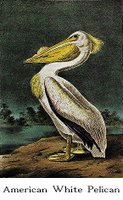Wishing for a gular
 127 Hudsonian godwit
127 Hudsonian godwit128 dunlin
129 Virginia rail
130 American white pelican
131 double-crested cormorant
MAY 26, EAGLE BLUFFS, sunny, 85—With the heat wave (it is just a wave, right?), a whole lot of gular fluttering was going on at Eagle Bluffs. On this visit the conservation area showed off its healthy populations of dickcissels in the fields and great blue herons in the water. Several of the great blues and two juvenile cormorants were vibrating their throat pouches (which contain blood vessels close to the skin surface) to dissipate heat.
Four pelicans, resting on a log in the water side by side with three great egrets, had gular surface area to spare but did not use it.
Elsewhere, three families of Canada goose goslings caused enough commotion for their parents to call a timeout. About 15 scooted over the water ten yards at a time, dove under—sometimes going momentarily bellyup—meowed to one another, and twice scattered a small group of Hudsonian godwits trying to feed in the shallows.
The godwits rank with the great-tailed grackle and Caspian terns as my best birds of the year. Originally I and another birder labeled them marbled godwits, but a long look through the spotting scope gave them away. Unfortunately I missed good April and May birding, and many spring migrants like the godwits won't return until fall.
I heard the rarely seen rail in a patch of cattails. My field guides describe the call as a clattering series of gik, skew, ti-dick, or wack, descriptions I can't improve. "Thin as a rail" comes from rails' abilities to compress (and avoid detection) in thick marsh vegetation. Biologists are forced to survey their populations using tape-recorded calls at dawn or dusk during breeding season and counting responses.
Never leave Eagle Bluffs in a hurry: on the way out I saw an otter hustling along the shoreline dragging what appeared to be a three-foot-long black rat snake.

0 Comments:
Post a Comment
<< Home